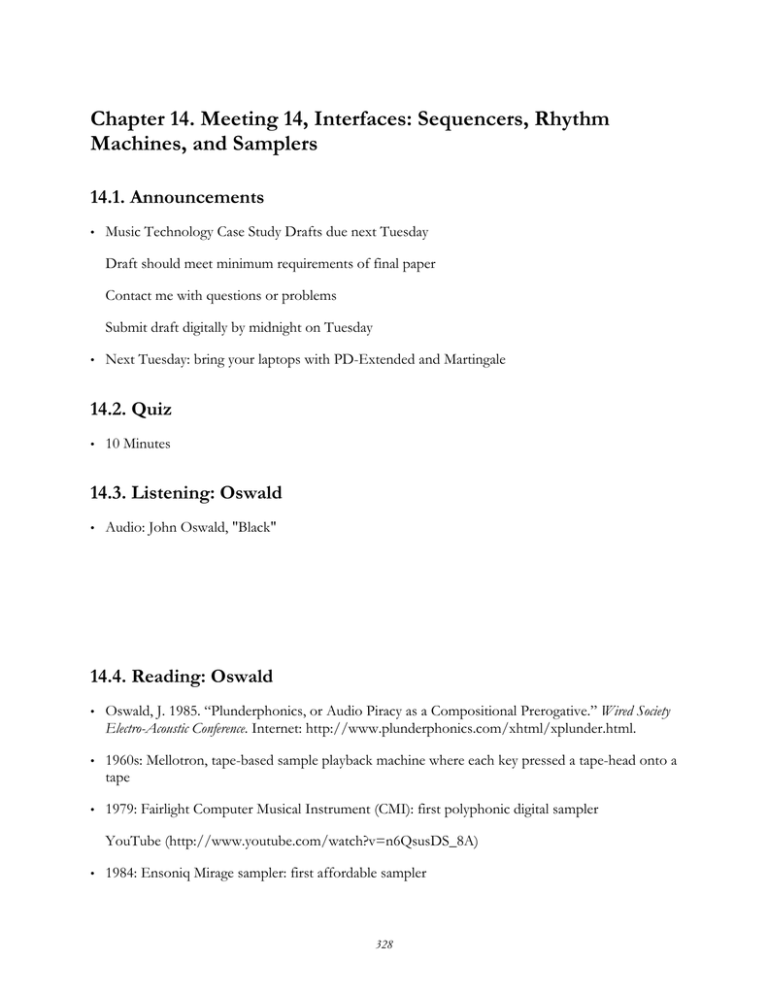
Chapter 14. Meeting 14, Interfaces: Sequencers, Rhythm
Machines, and Samplers
14.1. Announcements
•
Music Technology Case Study Drafts due next Tuesday
Draft should meet minimum requirements of final paper
Contact me with questions or problems
Submit draft digitally by midnight on Tuesday
•
Next Tuesday: bring your laptops with PD-Extended and Martingale
14.2. Quiz
•
10 Minutes
14.3. Listening: Oswald
•
Audio: John Oswald, "Black"
14.4. Reading: Oswald
•
Oswald, J. 1985. “Plunderphonics, or Audio Piracy as a Compositional Prerogative.” Wired Society
Electro-Acoustic Conference. Internet: http://www.plunderphonics.com/xhtml/xplunder.html.
•
1960s: Mellotron, tape-based sample playback machine where each key pressed a tape-head onto a
tape
•
1979: Fairlight Computer Musical Instrument (CMI): first polyphonic digital sampler
YouTube (http://www.youtube.com/watch?v=n6QsusDS_8A)
•
1984: Ensoniq Mirage sampler: first affordable sampler
328
•
Can an instrument or a timbre be considered a composition, like a sample?
•
Is it a problem that musical notation does not have a quotation mark?
•
How can a casual home listener become a more active listener?
•
Why, in Oswald’s view, might all popular or folk music be public domain?
14.5. The Sequencer
•
Numerous early synthesizers by Moog, Buchla, and ARP offered various forms of step
sequencers
•
At a minimum, provided a series of voltages that could be stepped through
•
A custom-shaped LFO
•
The Sonology Variable Function Generator: a custom sequencer capable at running at the audio
rate
329
14.6. Moog 960 Sequential Controller
•
Sequential controller provided a sequence of voltages that could be used to control any musical
parameter
•
Moog 960 Sequential Controller (1968)
330
Courtesy of the Electronic Music Studios at the University of California, Santa Cruz. Used with permission.
Courtesy of Synthesizers.com. Used with permission.
•
Permitted 8 steps, each step with three voltages
•
Each step could be played, skipped, or used as a point of loop-back
•
With a Moog 962, three rows could be treated as one 24 step sequence
•
Output could be shifted by another, independent voltage to create arpeggios
•
Examples
YouTube (http://www.youtube.com/watch?v=H2zpMKKamWI)
YouTube (http://www.youtube.com/watch?v=gNmzyZaqVwI)
331
•
Arturia virtual Moog modular, with row 1 modulating oscillator frequency and row 2 modulating
filter cutoff frequency
Courtesy of Arturia. Used with permission.
14.7. Drum Machines: Early Experiments: Rhythmicon
•
1931: Henry Cowell commissioned Termin to build a machine that could play complex rhythms
•
Could produce sixteen parts
•
Schillinger with the Rhythmicon
332
© Archives of American Art, Smithsonian Institution. All rights reserved.
This content is excluded from our Creative Commons license.
For more information, see http://ocw.mit.edu/fairuse.
•
American Mavericks: The Online Rhythmicon: site
(http://musicmavericks.publicradio.org/rhythmicon/index.html)
14.8. Drum Machines: Organ Accompanists
•
1959-1964: Wurlitzer Sideman
Analog sound sources employing tubes
333
© source unknown. All rights reserved.
This content is excluded from our Creative Commons license.
For more information, see http://ocw.mit.edu/fairuse.
YouTube (http://www.youtube.com/watch?v=QLgyQG8Pu8s)
14.9. Drum Machines: Analog Drums
•
1970s: Rhythm Ace, by Ace Tone (later Roland)
334
© source unknown. All rights reserved.
This content is excluded from our Creative Commons license.
For more information, see http://ocw.mit.edu/fairuse.
•
1978: Roland CR-78: programmable drum machine, analog drum voices
preset rhythms for Waltz, Bossa Nova and Rhumba; preset fills and variations
© source unknown. All rights reserved.
This content is excluded from our Creative Commons license.
For more information, see http://ocw.mit.edu/fairuse.
335
YouTube (http://youtube.com/watch?v=b0tdkP4GaGg)
•
1980: Roland TR-808 Rhythm Composer
transistor rhythm (TR); sixteen sounds; 32 programmable steps
Image courtesy of dAvid on Flickr.
YouTube (http://youtube.com/watch?v=jUx7ax62OBo)
•
Numerous software emulations available: http://www.hobnox.com/index.1056.de.html
14.10. Afrika Bambaataa
•
Associated with Afro-futurism
•
From the South Bronx and development of hip-hop in the late 1970s
•
Embrace of analog drum sounds and drum machines when not broadly accepted
14.11. Listening: Bambaataa
•
Audio: Afrika Bambaataa, "Planet Rock" 1982
336
14.12. Drum Machines: Digital Sampling
•
1979: Linn Electronics LM-1
First programmable sampling drum machine; 18 sounds, $5000
Courtesy of Roger Linn Design. Used with permission.
•
1982: LinnDrum
$3000
337
Courtesy of Roger Linn Design. Used with permission.
Courtesy of Roger Linn Design. Used with permission.
•
1984: Linn 9000
Sampling drum machine with MIDI sequencer
338
Courtesy of Roger Linn Design. Used with permission.
•
1988: Akai MPC60
Linn worked with Akai to create MPC series
339
Courtesy of Roger Linn Design. Used with permission.
•
recent: Akai MPC1000
64 track MIDI sequencer, 32 voice stereo sampler, compact flash data storage
340
© Akai. All rights reserved.
This content is excluded from our Creative Commons license.
For more information, see http://ocw.mit.edu/fairuse.
•
Pete Rock on the MPC (1:43, 2:43)
YouTube (http://youtube.com/watch?v=Faad8AmCl8c)
•
Examples
YouTube (http://www.youtube.com/watch?v=gFWazOuwwgw)
14.13. Listening: Public Enemy
•
Audio: Public Enemy: "Fight the Power"
14.14. Reading: Walser
•
Walser, R. 1995. “Rhythm, Rhyme, and Rhetoric in the Music of Public Enemy.” Ethnomusicology
39(2): 193-217.
341
Courtesy of University of Illinois Press. Used with permission.
•
Why does Walser see the use of transcriptions as important?
342
•
What are common arguments why rap is not music?
•
What techniques of sampler misuse and audio production are used to create the Bomb Squad
sound?
343
MIT OpenCourseWare
http://ocw.mit.edu
21M.380 Music and Technology (Contemporary History and Aesthetics)
Fall 2009
For information about citing these materials or our Terms of Use, visit: http://ocw.mit.edu/terms.




